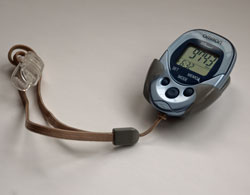Our good stuff
 ©Janet Allen
©Janet Allen This pottery is both functional and beautiful
We're trying to move away from having lots of stuff to having fewer, but very enjoyable, earth-friendly things that will last a long time. Most of what stores offer fails to meet these criteria.
(This parallels Americans' consumption of lots of cheap, unhealthy, low-quality food rather than less, but nutritious, high-quality food.)
Some stuff we simply enjoy; some stuff is just functional. It's wonderful when something fits both categories!
Not all stuff is bad for the environment or for us, but reducing the sheer quantity of stuff is important. Excessive amounts of even "good stuff" is a problem.
Stuff we enjoy
Most of the material things we enjoy are also functional, except, perhaps, for a few pieces of artwork.
Some stuff we enjoy are as simple as a few of our mugs. They weren't the cheap dollar-store variety, but not expensive either. They are just the right size and shape with just the right heft that makes them enjoyable to use. They may not last forever, but we're reasonably careful with such things, and they should last a long time.
But we reserve our real enjoyment for living things, and we get much joy from watching the plants and animals in our yard. And the world's wisdom literature always cautions against getting attached to non-living, material stuff.
Cheapest isn't always the least expensive
 ©Janet Allen
©Janet Allen My pedometer
Sometimes you just get what you pay for, and cheap things can often be cheaply made and either don't perform as well as advertised or just don't last very long.
Here's one example. My pedometer was more expensive (about $25-$30), but it's accurate, versatile, and is still performing well after a number of years. I wish I had bought this one first instead of wasting money on cheaper, but less well made pedometers (a $5 one and then a $10 one).
It would have been cheaper in the long run to buy the more expensive brand first. However, this brand comes in more than one model, and this one is the medium-priced one. I imagine the cheaper model of this same pedometer would have performed as well, and it turns out we didn't need the fancy features, just the basic good construction.
This is just a small example, but the same principle applies to larger things. For important things (and our pedometers are a surprisingly effective and important part of our fitness activities), getting quality stuff ultimately leads to the least waste.
Of course, we can't buy the most expensive versions of all the stuff we've bought in the past. That's where reducing our consumption comes in.
But some small, inexpensive things are great
 ©Janet Allen
©Janet Allen My pencils - a simple joy
Not everything that's "good" has to be expensive. Some simple things are inherently inexpensive.
For example, I really enjoy my mechanical pencils, since I can fill them with 2B lead—the really soft kind—and I can replace the erasers when needed.
Most of my pencils were very inexpensive (about 25¢ about ten years ago), but I enjoy them because I can advance the lead by clicking the top, I can fill the pencil by taking the whole top off, not just the eraser, and I like the thickness of the pencil.
It's a good thing I went overboard buying these back then since this particular kind is no longer available. I have a lifetime supply. Definitely a simple pleasure (and maybe even an irrational one), but at least for me, still a pleasure.
The downside, of course, is that they're plastic; on the other hand, I've been using them for a decade already rather than sharpening a multitude of wooden ones, and they'll last forever (which of course is the problem with plastic stuff).
So some simple pleasures can be inherently inexpensive. It's the stuff that has been produced too cheaply to perform its function well, has been produced under unjust working conditions, or that doesn't last that's a big problem.
One important principle we think about is that the amount of environmental damage is roughly equal to the weight of the product. I'm sure there are exceptions, but we generally think more carefully about big, heavy items than about small ones.

